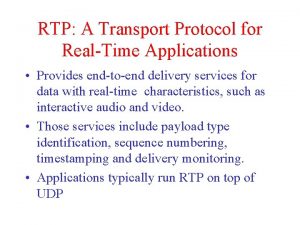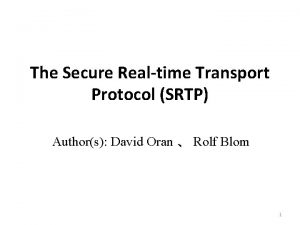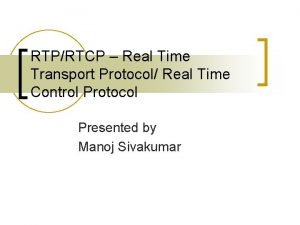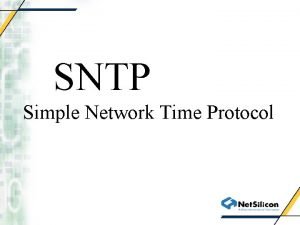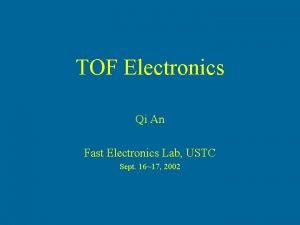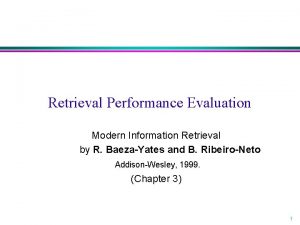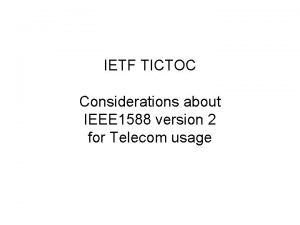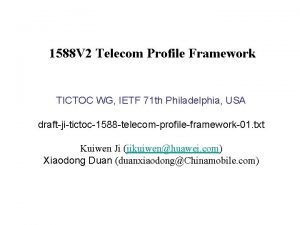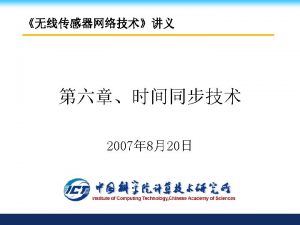Precision Time Protocol IEEE 1588 v 2 TICTOC






















- Slides: 22

Precision Time Protocol IEEE 1588 v 2 TICTOC BOF IETF Prague 2007 Ron Cohen Resolute Networks ronc@resolutenetworks. com

Agenda • • • Status PTPv 1 overview PTPv 2 major additions Transparent clocks PTP and TICTOC 2

The Precision Time Protocol (PTP) • PTPv 1 published in 2002 • Industries involved: v 1: Industrial Automation, T&M, Military, Power Generation and Distribution § v 2 : Audio-Visio Bridges (802. 1 AS), Telecom and Mobile § • Symposia in 2003, 2004, 2005, and 2006. 2007 in Vienna • Products: Microprocessors, GPS Linked Clocks, Boundary Clocks, NIC Cards, Protocol Stacks, RF Instrumentation, Aircraft Flight Monitoring Instruments, etc. • Information: http: //ieee 1588. nist. gov • Version 2 PAR approved March 2005. Technical work completed 3

PTPv 1 objectives • • • Sub-microsecond synchronization Intended for relatively localized systems Applicable to networks supporting multicast Simple, administration free installation Support heterogeneous systems of clocks with varying precision, resolution and stability • Minimal resource requirements on networks and host components 4

Protocol overview • Timing Protocol Align slaves to master time § Measure delay between master and slave § Measure per-link delay (v 2) § • Synchronization Hierarchy ‘routing’ Protocol Automatic Best Master Clock Algorithm § Determines the master-slave synchronization clock tree hierarchy § • Management Protocol § Configuration and performance monitoring 5

PTP Master-Slave Hierarchy *Clock symbols taken from ITU-T SG 15 ‘synchronization modeling components – time’ contribution #249 Geneva-2007 by Mike Gilson of BT 6

Timing Protocol Operation 7

Precision using HW time-stamping 8

1 -step and 2 -step clocks • 1 -step clock updates accurate timestamp (t 1) in Sync message • 2 -step clock sends accurate timestamp (t 1) in a Follow_Up message Simplify design while avoiding queuing noise § Ease integration of security extensions § 9

PTPv 2 major additions • • • Synchronization accuracies better than 1 nanosecond Higher sampling/message rates Unicast communication Correction for asymmetry Transparent clocks Redundancy Configurable synchronization hierarchy Decouple sync messaging from hierarchy signaling Formal mechanisms for message extensions Mappings to UDP/IPv 4&6, Ethernet w/o VLAN, (also Device. Net™, PROFINET, Control. Net™) 10

Sync and Delay-Req formats 11

End-to-End Transparent Clocks E 2 E TCs cancel queuing and processing delays 12

Peer-to-Peer Transparent Clocks P 2 P TCs cancel queuing, processing and propagation delays 13

Peer Delay Measurement (Optional) 14

E 2 E TC Enabled PSN Packet queuing and processing is removed 15

P 2 P TC Enabled PSN Topology change does not effect slave performance 16

Comparison between switches Boundary Clock E 2 E TC P 2 P TC Clock Synchronized Syntonized Topology limitations √ None Homogenous* with 1: 1 connection each link State maintained • • • Temporal message state for 2 -step TCs • • Slave scalability √ Hierarchical Master sees all slaves √ Hierarchical (multicast Sync) Linear scalability Control wander accumulation √ √ Topology change Measure new delay √ Pre-compute link delays Per port state Per unicast contract state Per link state Temporal message state for 2 -step TCs *restriction can be relieved using P-delay over MPLS 17

PTP protocol extensions • Define a profile that selects optional feature set, default and range of values • Define TLV extension to messages • Define flag-fields to be carried in event messages • Define alternate management scheme (SNMP) • Define alternate synchronization hierarchy selection (routing) algorithm • Define additional transport mapping (PTP over MPLS) • Define alternate clock quality levels and attributes 18

PTP and TICTOC Requirements Description Services Frequency, Phase, Time and meta-Time services Precision Nano-seconds accuracy demonstrated Sub nano-seconds granularity Incremental Add Transparent clocks or Boundary clocks to improve performance if required in critical junctions Performance Telecom grade performance has been demonstrated over non -PTP-aware networks Scalable Use of boundary clocks and/or transparent clocks to scale and maintain performance limits Robust to master failures Smart slaves synchronizing to two domains or two masters in a single domain. Alternate master takes over when master fails Robust to topology P 2 P mechanism allows to pre-compute link-delays to changes minimize effect of topology change 19

PTP and TICTOC Derived Requirements Description HW friendly Correction field is scaled nano-seconds. All computations by transparent clocks are performed on correction field Correction field is in a fixed position from beginning of PTP header Single Timestamp in fixed position immediately after PTP header for master and slave HW setting Heterogonous design options 2 -step clocks simplify master designs 1 -step transparent clocks do not need to maintain per master -slave message states Slave friendly Timescale (Timestamps) is continuous. Timestamps do not ‘jump’ or ‘miss’ one second when leap event occurs Time-stamps do not roll over 20

Questions? Ron Cohen Resolute Networks ronc@resolute. Networks. com

NTP message format 22
 Non precision tools
Non precision tools Semi precision attachments
Semi precision attachments Single precision vs double precision
Single precision vs double precision Elapsed time
Elapsed time A transport protocol for real time applications
A transport protocol for real time applications Real time messaging protocol
Real time messaging protocol Secure real-time transport protocol
Secure real-time transport protocol Real time control protocol
Real time control protocol Simple ntp
Simple ntp Real time control protocol
Real time control protocol High precision dsp
High precision dsp Vmebus
Vmebus Precision optical lab
Precision optical lab Tefal aquaspeed precision
Tefal aquaspeed precision Standard deviation sig figs
Standard deviation sig figs Ti precision labs op amps
Ti precision labs op amps High precision vs high recall
High precision vs high recall Tdr running
Tdr running Reliability coefficient
Reliability coefficient Ti precision labs
Ti precision labs Ptc-lms
Ptc-lms Leicester precision medicine institute
Leicester precision medicine institute Contoh presisi
Contoh presisi




